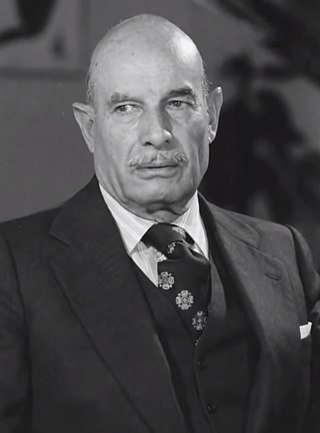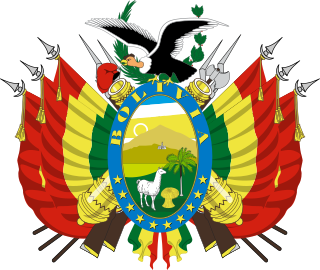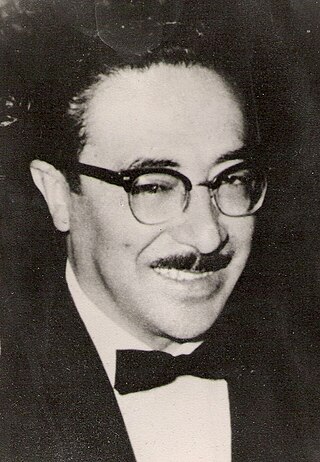
Hugo Banzer Suárez was a Bolivian politician and military officer who served as the 51st president of Bolivia. He held the Bolivian presidency twice: from 1971 to 1978 as a military dictator; and then again from 1997 to 2001, as a democratically elected president.

The Revolutionary Nationalist Movement is now a centre-right, conservative political party in Bolivia. It was the leading force behind the Bolivian National Revolution from 1952 to 1964. It influenced much of the country's history since 1941.

Gualberto Villarroel López was a Bolivian military officer who served as the 39th president of Bolivia from 1943 to 1946. A reformist, sometimes compared with Argentina's Juan Perón, he is nonetheless remembered for his alleged fascist sympathies and his violent demise on 21 July 1946.

Ángel Víctor Paz Estenssoro was a Bolivian politician who served as the 45th president of Bolivia for three nonconsecutive and four total terms from 1952 to 1956, 1960 to 1964 and 1985 to 1989. He ran for president eight times and was victorious in 1951, 1960, 1964 and 1985. His 1951 victory was annulled by a military junta led by Hugo Ballivián, and his 1964 victory was interrupted by the 1964 Bolivian coup d'état.

Hernán Siles Zuazo was a Bolivian politician who served as the 46th president of Bolivia twice nonconsecutively from 1956 to 1960 and from 1982 to 1985. He also briefly served as interim president in April 1952, and as the 27th vice president of Bolivia from 1952 to 1956.

Arica is a commune and a port city with a population of 222,619 in the Arica Province of northern Chile's Arica y Parinacota Region. It is Chile's northernmost city, being located only 18 km (11 mi) south of the border with Peru. The city is the capital of both the Arica Province and the Arica and Parinacota Region. Arica is located at the bend of South America's western coast known as the Arica Bend or Arica Elbow. At the location of the city are two valleys that dissect the Atacama Desert converge: Azapa and Lluta. These valleys provide citrus and olives for export.

The vice president of Bolivia, officially known as the vice president of the Plurinational State of Bolivia, is the second highest political position in Bolivia. The vice president replaces the president in his definitive absence or others impediment and is the ex officio President of the Legislative Assembly.

José Enrique Hertzog Garaizábal was a Bolivian politician who served as the 42nd president of Bolivia from 1947 to 1949. He resigned in 1949, and died in exile in Argentina.

Wálter Guevara Arze was a Bolivian statesman, cabinet minister, writer, and diplomat, who served as the 54th president of Bolivia on an interim basis in 1979.
Bolivia's defeat by Paraguay in the Chaco War of 1932–1936 marked a turning point in the modern history of Bolivia. Significant loss of life and territory discredited the traditional ruling classes, while service in the army produced stirrings of political awareness among the indigenous people. Many of the contested Gran Chaco region was surrendered to Paraguay. In return, Bolivia was given access to the Paraguay River where Puerto Busch was founded, and, with this, free access to the Atlantic Ocean through international waters was possible. In 1936, Standard Oil's Bolivian operations were nationalized, and the state-owned firm Yacimientos Petroliferos Fiscales Bolivianos (YPFB) was created. From the end of the Chaco War until the 1952 Bolivian National Revolution, the emergence of contending ideologies and the demands of new groups convulsed Bolivian politics.

Bolivia has had seventeen constitutions, including the present one, since its foundation in 1825.

The Republican Socialist Unity Party was a political party founded on 10 November 1946 in Bolivia as the fusion of the Republican Socialist Party, the Genuine Republican Party, the United Socialist Party, and the Independent Socialist Party.

The Bolivian Revolution of 1952, also known as the Revolution of '52, was a series of political demonstrations led by the Revolutionary Nationalist Movement (MNR), which, in alliance with liberals and communists, sought to overthrow the ruling Bolivian oligarchy and implement a new socioeconomic model in Bolivia. Its main leaders were the former presidents Víctor Paz Estenssoro and Hernán Siles Zuazo. The MNR government after this Revolution lasted from 9 April 1952 until the coup of 4 November 1964. In these twelve years, there was a co-government and at the same time a power struggle between the party and the labor unions.

Jaime Otero Calderón was a Bolivian congressman, mayor, diplomat, cabinet minister, political leader, intellectual, and journalist.
Bolivia has experienced more than 190 coups d'état and revolutions since its independence was declared in 1825. Since 1950, Bolivia has seen the most coups of any other country. The penultimate known attempt was in 1984, two years after the country's transition to democracy in 1982. The most recent attempted coup d'état was on 26th June 2024 led by General Juan José Zúñiga.

Enrique Hertzog assumed office as the 42nd president of Bolivia on 10 March 1947, and his term ended upon his resignation on 22 October 1949. A physician who served in various ministerial positions since the 1920s, Hertzog was elected as the head of the Republican Socialist Unity Party (PURS) ticket in the 1947 general elections.

Gabriel Gosálvez Tejada was a Bolivian politician, journalist, economist, and diplomat. Throughout his political career, Gosálvez held various ministerial officers and diplomatic posts as a member of the United Socialist Party. When that party merged into the Republican Socialist Unity Party, Gosálvez was presented as its presidential candidate in the 1951 general election.

Mamerto Urriolagoitía assumed office as the 43rd President of Bolivia on 24 October 1949, and his term was terminated upon his resignation in a self-coup on 16 May 1951. The vice president of Enrique Hertzog, Urriolagoitía had already been serving as acting president since 7 May 1949 but officially took office after Hertzog presented his resignation on 22 October.

Hernán Terrazas Céspedes was a Bolivian general, politician, and diplomat who served as Mayor of Cochabamba during the era of dictatorships in Bolivia. Early in his military career he was stationed in the Rocha Regiment and, as a second lieutenant, formed part of the rebel lines in Incahuasi during the 1949 coup d'état in Bolivia.

Luis Nardín Rivas was a Bolivian politician who served as Mayor of La Paz twice; (1942-1943) and (1948-1950). He was a prominent politician during the final stages of the oligarchic Republic of Bolivia and an ally of the old elite. After his second term ended, he would become Minister of National Economy (1950-1951), and would briefly work as a diplomat in the Bolivian delegation to Brazil in 1951. After the Bolivian National Revolution of 1952, he was exiled to Peru where he spent the rest of his life.



















